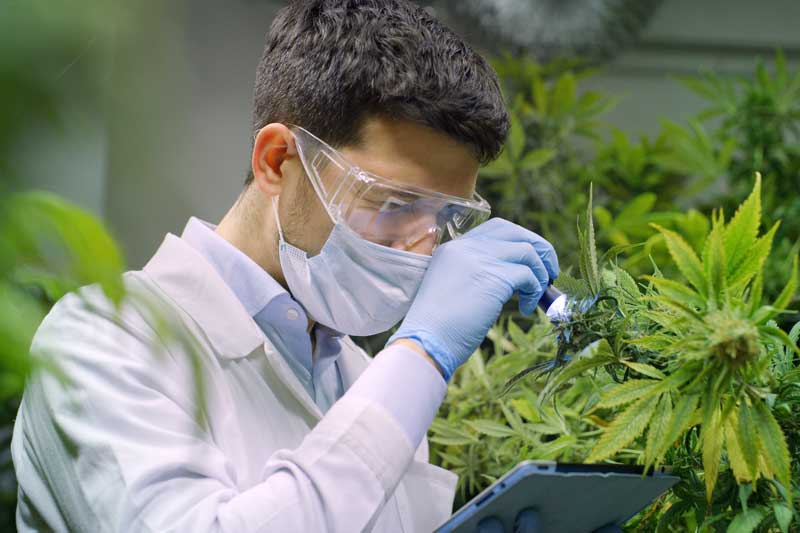Although the value of data analytics has already been made apparent within the retail and distribution side of cannabis, it’s only recently started to gain traction within the cultivation community.,
Every strain of cannabis has its own specific needs and ideal growing conditions, and the only way to ensure these needs are being met is by collecting the right data. With the proper analytics platform, growers can get a clear picture of their facility’s productivity and ensure that they’re taking the right steps to maximize their yield and ROI.
Temperature
In artificial environments like greenhouses, temperature regulation can pose a unique challenge for many growers. High temperatures (80-90° F) can slow down growth and reduce the potency of flowering plants. Furthermore, high temperatures can compromise a plant’s immune system and increase the risk of mites, wilting, stretching, nutrient burn, and other potential ailments.
Unfortunately, there are a lot of factors that influence greenhouse temperature, ranging from the shape of the room to the types of light fixtures used. This can make it very difficult for growers to maintain a consistent and healthy ecosystem without creating individual microclimates.
Thankfully, using a system of strategically placed thermometers and thermal imaging cameras, cultivators can collect data on how temperature varies across their greenhouse. This data can then be used to employ different measures (such as fans) to address any potential hotspots.

Water content
In an industry where the quality of the product is so dependent on even minute variations in its chemical profile, the slightest variations in moisture levels can have a significant effect on the resulting flower. Producing the best yield requires cultivators to provide the perfect amount of moisture at any given time. Therefore, it’s critical that growers continually collect and analyze irrigation data to identify what’s working and what isn’t.
Additionally, growers shouldn’t downplay the importance of water quality when it comes to their plants. Just as excessive watering can be detrimental to a plant’s growth, so can excessive minerals and nutrients. Municipal water sources are often treated with chemicals like chlorine, while local water sources may be contaminated with fertilizer salts or pathogens.
As a general rule of thumb, cannabis cultivators should be collecting certain metrics like pH, alkalinity, hardness, electrical conductivity, and nitrates/ammonium.
Humidity
Although often dismissed by cultivators, humidity swings can have a significant impact on cannabis growth and yield. Throughout a plant’s life, cannabis humidity preferences can range from 70% as a seedling to 30% while flowering. Excessive moisture can lead to mold and fungi, while the lack thereof can cause leaves and flowers to brown and yellow or even fall off.
Like with other environmental factors, cannabis plants need just the right amount of moisture to sustain consistent growth and produce a bountiful yield. By measuring how much data is in the air, cultivators can determine when more moisture needs to be added and when it needs to be removed.
On top of the risk to the plants, running dehumidifiers, misters, and AC units when they’re not necessary can cost a business thousands of dollars in wasteful electric bills.

Lighting performance
Just like with any form of agriculture, proper lighting is critical to producing the correct potency and yield. This is why cannabis cultivators need to employ some of method of measuring lighting performance within their greenhouse.
On top of ensuring that their lighting is within acceptable parameters, growers can use past data to adjust their output as needed and make necessary preparations for upcoming maintenance like bulb-replacements.
Unlike other crops, cannabis yield can’t be measured in weight alone. The potency of a bud can have major consequences on its value, so it’s important that growers are taking steps to understand the relationship between their lighting and the final product. Thankfully, there are a wide variety of systems available to collect relevant lighting data such as light intensity, photoperiods, temperature, and light quality.
Carbon dioxide concentration
Carbon dioxide (CO2) is an essential part of photosynthesis and is needed by plants for producing energy. Increased levels of CO2, when introduced correctly, can produce healthier plants with increased yields. But the question is, how do you make sure you’re using the right amount of CO2 and that it’s being equally distributed?
On average, cannabis plants will experience significant increased growth at around 1200-2000 parts per million (ppm). That said, your plants can become sick from excess CO2 if you lack the lighting necessary to convert it to usable energy.
This is where data becomes so important. Without accurate and exact measurements, you could be throwing away thousands of dollars in plants that aren’t being allowed to meet their potential or are dying from CO2 poisoning. Additionally, this data can be used to compare different yields and CO2 levels and monitor for any system malfunctions (such as a depleted tank).

Learn more
In an industry where a single plant can be worth thousands of dollars, cannabis cultivators don’t have a lot of room for error when it comes to their greenhouse. To ensure that plant growth is meeting desired benchmarks and producing strong yields, growers need the detail-driven nature of data analytics. To learn more about how analytics can help your cannabis business maximize ROI and cut costs, check out our white paper—”Cannabis Technology Landscape—Bridging the Gap with Analytics.”
- How Spirits Brands Can Improve Brand Loyalty with Data Analytics - January 30, 2024
- The Collapse of Herbl, and How Other Cannabis Distributors Can Avoid the Same Fate - January 24, 2024
- Top 5 Blog Posts of 2023 - December 28, 2023




